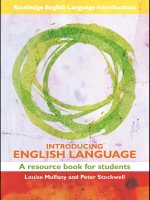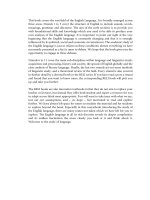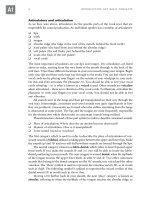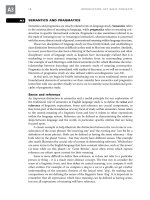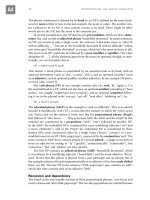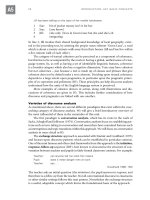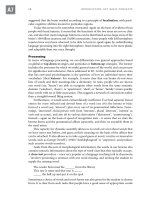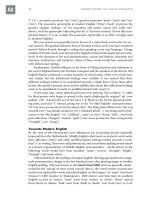Introdungcing English language part 7 pdf
Bạn đang xem bản rút gọn của tài liệu. Xem và tải ngay bản đầy đủ của tài liệu tại đây (315.88 KB, 6 trang )
22 INTRODUCTION: KEY BASIC CONCEPTS
Jill has been talking on the topic of her mobile hairdresser.
1 Sue: bit of pocket money isn’t it for her
2 Sue: [you know]
3 Jill: [she only ] lives in Green Lane but she said she’s eh
4 emigrating
In line 3, Jill invokes their shared background knowledge of local geography, exter-
nal to the preceding text, by uttering the proper noun referent ‘Green Lane’, a road
which is about a twenty-minute walk away from their homes (Jill and Sue live within
a five-minute walk of each other).
The category of textual cohesion can be perceived as a component of coherence,
but this has to be accompanied by the receiver having a global, unified sense of a lan-
guage system. So, as well as having a set of identifiable linguistic features, coherence
is a broader category which also has a cognitive dimension. Texts may have cohesion
but not coherence – just because a text is made up of clauses and phrases that give
cohesion does not by default make a text coherent. Deciding upon textual coherence
depends to a large extent upon pragmatics, in particular upon the pragmatic princi-
ples of co-operation and politeness (B3). These principles can help discourse analysts
understand how the unity of the English language system is perceived.
More examples of cohesive devices in action, along with illustrations and dis-
cussions of coherence are given in D5. This includes further consideration of how
discourse and pragmatics are linked with one another.
Varieties of discourse analysis
As mentioned above, there are several different paradigms that exist within the over-
arching category of discourse analysis. We will give a brief introductory overview of
the most influential of these in the remainder of this unit.
The first paradigm is conversation analysis, which has its roots in the work of
Sacks, Schegloff and Jefferson (1974). Conversation analysts focus on establishing pat-
terns such as turn-taking in conversation and researchers have examined features such
as interruptions and topic transitions within this approach. We will focus on conversation
analysis in more detail in B5.
The exchange structure approach is associated with Sinclair and Coulthard (1975)
and focuses upon discourse patterns which can be established in particular contexts.
One of the most famous and often-cited frameworks from this approach is the initiation,
response, follow-up sequence (IRF), best known to characterise the structure of con-
versation between teachers and pupils in fairly formal classroom contexts. For example:
Teacher: can anyone tell me what this means
Pupil: does it mean danger men at work
Teacher yes . . .
(Coulthard 1985: 135)
The teacher asks an initial question (the initiation), the pupil answers in response, and
then there is a follow-up from the teacher. Not all conversational discourse in classrooms
or other similar settings follows this neat pattern. Nonetheless the exchange structure
is a useful, adaptable concept which forms the foundational basis of the approach.
EARLY LANGUAGE ACQUISITION 23
Look out for the IRF pattern in your everyday discourse. In what kinds of
contexts does it occur? Who uses which strategy? What can this tell you about the
relationship between speakers?
Another paradigm for discourse analysis research is the ethnography of speak-
ing. This is ambitiously designed to characterise all of the different factors that
influence how we speak with one another. The most prominent figure in this field is
Dell Hymes (1974). He coined a very useful analytical framework known as the
SPEAKING model, whereby each of the individual letters refers to part of the
analytical process:
Setting and scene: time, place and cultural setting of the interaction
Participants: who is taking part
Ends: expected outcomes
Act: form and content of exactly what is said
Key: tone or manner in which it is said
Instrumentalities: choice of channel, such as spoken or written
Norms: established expectations for speaking behaviour
Genre: type of utterance (lecture, formal speech, etc.)
Yet another paradigm of discourse analysis is known as critical discourse analysis
(CDA), most prominently associated with the work of Norman Fairclough (1995).
Researchers who follow a CDA approach have the overall aim of revealing hidden
ideological power structures which are contained within discourse. Critical discourse
analysts aim to do this by conducting close textual analyses of spoken and written data
which are then analysed as part of the constraints of the wider socio-cultural context
where the texts are produced. CDA researchers often have a clearly stated, overt polit-
ical purpose for conducting their research, such as revealing racist discourses within
particular texts. They often utilise techniques from systemic functional linguistics
(detailed in B4) to help reveal hidden ideological meanings within the language system.
This brief overview has presented a range of different areas of discourse analysis,
emphasising that it is a wide and varied discipline – dedicated researchers have also
used a number of different tools and techniques to investigate a plethora of spoken
and written texts. Some researchers mix together different elements of the above
approaches, whereas others stick quite rigidly to the specifics of their chosen
approach. We will develop these issues in B5 and C5.
EARLY LANGUAGE ACQUISITION
We human beings are all born too early. To be at a comparable stage relative to the
adult state of other mammals, human pregnancy should be anything up to double the
nine months that it has been for thousands of years. Human babies are born unable to
walk, unable to see very far, unable to manipulate our own bodies much at all, and
unable to speak or comprehend other humans. We remain in this dependent state for
several years, except for the rapid speed with which we acquire language. Babies’ large
A6
24 INTRODUCTION: KEY BASIC CONCEPTS
evolved brains are housed in large skulls, which would kill their mothers during birth
if gestation were much longer, but these large brains are what allow us to learn lan-
guage, and language serves to create culture and civilisation to compensate for our
dangerously weak physical capacities in the early years.
All humans acquire the language that they are exposed to, and we can acquire
several languages at once. The stages which babies go through are broadly the same
around the world; there is no such thing as a language that is more difficult than
others. The only differences arise where some structural levels are more important in
one language than another. For example, English has fewer and simpler inflections
(suffixes such as plural ‘-s’, past tense ‘-ed’, present participle ‘-ing’, and some others)
than Hungarian (with its 18 cases and numerous affixes to indicate grammatical
function), so Hungarian babies take a short while longer to master the acquisition of
inflections than do their English counterparts, but overall Hungarian children match
their English-speaking peers pretty much equally in language competence and per-
formance. Within English-speaking families, babies acquire aspects of English at varying
rates, so the ages of acquisition given below are very broad, but roughly consistent.
Pre-birth
Language acquisition begins in the womb, as sounds from outside begin to familiarise
a baby with the tone of speech, especially the mother’s and others’ voices during late
pregnancy. Babies are born with the human hardwiring in the brain to learn language,
and have already begun to recognise the characteristic tonal patterns and rhythm of
the language of their particular society. The capacity for hearing sounds and differ-
entiating them, and the physical practice of moving mouth, lips and tongue are both
developing before birth.
Birth to six months
Practice in the womb means babies can suck and swallow as soon as they are born,
and from around the eight-weeks stage, the oral and vocal tract sounds associated with
these actions can be heard as cooing. The lip-sounds /me/ and /be/ and the swallow-
ing sounds /ge/ and /ke/ involve the physical extremes of the mouth (front and back)
pronounced with the tongue at rest as the mid-vowel /e/. Babies play around with
these sounds, producing the stereotypical ‘mama’ and ‘gaga’ sequences – these can-
not yet be said to be words, since the baby has no idea that sound and sense are
connected. Over the next few months, babies fill out the consonant sounds between
these extremes, and vary their vowel quality as they gain more and more control over
the tongue.
As the initial occasional cooing gives way to more extensive babbling, babies pro-
duce playful strings of sounds. At first these range over all the possible sounds that a
human mouth can make, but gradually those sounds that are not part of the phono-
logical system of the community’s language fall away, and the baby babbles only with
the sounds that will be used in her native language. Babbling sequences will often take
on the intonation contour of the native language too, so babies sometimes sound like
they are asking questions, making assertions, complaining, telling a story or engaging
in question-and-answer with an adult. In all these cases, they are simply modelling
the extended sound pattern on what they hear, without any understanding.
SWIN|KCrEIB1Qqc8svpQueSEh0w==|1282035742
EARLY LANGUAGE ACQUISITION 25
Six to eighteen months
Babbling gradually develops into holophrastic speech consisting of one-word utter-
ances. By around 12 months old, a baby seems to be able to understand some words
spoken by others, especially if they are often-repeated words attached to familiar phys-
ical objects. Their own production ability, though, lags far behind their capacity for
comprehension. The single-word utterances do at least count as language production,
as the child gradually realises that certain words in the right context produce desired
effects. Sounds have thus become attached to meanings, in the child’s mind, and words
are no longer just playful sounds but are labels.
By the end of the holophrastic period, a child’s vocabulary might be as large as
150 words, with many of these words having extended meanings and covering whole
domains. For example, ‘hot’ might refer to any dangerous object or situation, includ-
ing ovens, open fires, radiators, knives and implements in general; ‘button’ might not
only refer to a button on a shirt, but also the shirt itself, and clothes in general; an
unusual word that has become a vocabulary item might stand for a particular every-
day object (‘monkey’ as a word for ‘banana’, for example).
The process of establishing the appropriate range of a word is its packaging.
This can happen because new vocabulary terms are learned that cover part of the
previous domain of an existing word (so ‘fire’ becomes attached to an open fire,
thus removing some of the applicability of ‘hot’), or because the child learns that
a word that has been metaphorically attached (like ‘monkey’ for a banana) in fact
refers to something else specific (a monkey). All these words are fixed, though:
they do not vary; they do not have plurals or past tenses attached to them; they are
not combined with other words.
Eighteen months to two years
Up to this stage, a child might repeat the same word over and over (echolalia). However,
once a child learns to combine different words, at first in two-word phrases (con-
catenation), there is an explosively rapid advance in ability. Multiple-word utterances
obviously allow sequencing rules to be demonstrated, so a child’s syntactic develop-
ment in terms of her production can be observed. The two words in utterances are
almost always connected by some semantic relationship.
For example, a child might produce ‘baby shoe’ (possession), ‘get milk’ (impera-
tive), ‘milk allgone’ (negation), ‘that car’ (nomination), ‘byebye teddy’ (greeting),
but not, say, ‘allgone that’ (deictic indexing) or ‘baby teddy’ (to mean a small teddy
rather than the baby’s teddy). Note that words that an adult might perceive as two
words (‘allgone’) are treated at this stage by the child as a single fixed word: she would
never say ‘all milk gone’ or vary the form ‘allgo milk’.
Prepositions begin to be acquired, with the literally spatial ones ‘in’, ‘on’ and ‘under’
usually the first to be used. The differentiation of ‘I/me’ and ‘you’ marks the begin-
ning of a sense of deictic projection. The packaging of words into domains that begin
to match the adult senses of words continues with the child beginning network build-
ing of words: those items that are semantically connected (‘dog, cat, pet’; or ‘car, seat,
go’) are mentally grouped together and are spoken in groups. This process of semantic
field learning continues throughout life, but it begins here. By age two, a child has
an active vocabulary of around 500 words, but can certainly understand many more.
26 INTRODUCTION: KEY BASIC CONCEPTS
Action sequences are acquired late in this stage (‘fill drink’, ‘Mammy pick’, ‘give
teddy’), before the child begins to produce three-, four- and more word utterances in
a rapid period of expansion. By two years old, a child will typically have a vocabulary
of around 500 words. It is at this stage that regular inflectional endings will be
acquired too. Plural ‘-s’ and past tense ‘-ed’ will begin to appear as the child moves
on from the two-word sequence. These are often generalised across irregular forms
(‘bringed’,’ ‘runned’, ‘sheeps’, ‘mouses’), and are even back-formed on principle (so
a single item of ‘clothes’ is a ‘clo’, a single chunk of ‘cat-mix’ food is a ‘cat-mic’).
Children’s pronunciation also develops rapidly. Almost all the vowel sounds that
a child will need in her language are available by the age of two, though the acquisi-
tion of the complete consonant set is often not finished until age five or more.
Specific patterns can be observed, for example omitting final consonants, especially
dentals (/ka/ for ‘cat’, /fu£/ for ‘food’); omission of unstressed syllables (/ape/ for ‘apple’,
/nane/ for ‘banana’); /w/ and /j/ variably for /l/ and /r/ (/wεd/ for ‘red’, /jεgek/ for
‘lego’, /kkdew/ for ‘cuddle’), and other systematic mismatches in consonant usage.
However, around two-thirds of all the child’s utterances in this phase will be articu-
late enough to be intelligible to an adult.
Two to five years
Through these years, the child’s language develops to the point at which it is more
or less fully formed. The remaining consonants and clusters are perfected. The
appropriate intonations for different speech acts such as questioning, commanding,
pleading, being sarcastic, and so on are all mastered. Accent features of the speech
community (see A9) are accurately performed. Active vocabulary rises towards 2,000
words, and keeps accelerating throughout later childhood towards the adult norm of
around 40,000 words.
Once the two-word phrase period has passed, a child’s syntactic ability becomes
highly complex. The ability to form questions by reversing the verb and auxiliary, the
ability to form passives by deleting the subject as agent, the ability to form negations,
the ability to create complex phrases using adjectival modifiers and adverbials, the
ability to form subordinate and relative clauses, the ability to conjoin clauses to
articulate complex reasoning all appear very rapidly in these years. While they are
still not perfected by age six, the basics are usually there.
Conversational and other pragmatic skills also develop fast. Children learn how to
hold the floor, how to interrupt appropriately, how to negotiate politeness strategies,
how to be rude and insulting with accuracy, how to generate empathy and how to
express abstract concepts and emotions. Children will start to develop the begin-
nings of narrative skills that allow them to recount a story. In the next few years, they
will enrich this skill with the ability to pause the story for asides, explanations, com-
mentary, moralising, and comparison with other stories; they will eventually develop
the skill of telling the story out of sequence for literary impact.
Six years old
From this point, something of major significance seems to happen in human brains.
Having acquired a rich capacity for language (either one or several languages), the
child’s brain begins to switch off its acquisition capability. From this critical age point,
PSYCHOLINGUISTICS 27
any further languages that are to be gained will have to be learned rather than
acquired. Though children’s minds up to adulthood find it generally easier to learn
new languages, nothing compares with the ease of the first language(s) acquisition.
Around this point, other cognitive skills also seem to close down: babies and toddlers
can differentiate faces of different ethnic and racial origins very easily, but from this
age onwards, face-types that the child does not commonly encounter will appear very
similar to each other. Preferred smells and tastes will be established at this point that
shape adult preferences.
All of this suggests that there is some reality to the notion that our human brains
are genetically hardwired with a language acquisition device (which may have a wider
scope as a cognitive function setup device) which allows us to acquire any languages
we encounter in infant life, and then shuts down. By early puberty (between 11 and
14 years old), our astonishing childhood capacity has gone.
PSYCHOLINGUISTICS
As an interdisciplinary field, psycholinguistics draws on many of the experimental
scientific methods of psychology as well as the theoretical categories of linguistics.
Psycholinguistics touches on several of the topics covered elsewhere in this book,
especially language acquisition (A6) and syntax (strand 4). Of course, for much of its
history, linguistics has been implicitly psychological and cognitive, in the sense that
researchers have tried to formalise rules that are interior in individuals’ minds.
Psycholinguists have attempted to test out some of the theoretical models
hypothesised in linguistics, by using test exercises with small groups of people, by
observing physical analogues of mental activity using techniques such as eye-tracking
and magnetic resonance imaging (MRI) scans, and by deducing the workings of normal
behaviour on the basis of mental disorders or brain damage.
The brain and language
For example, on the basis of evidence from people with lesions or injuries to certain
parts of the brain, it is clear that certain areas in the brain are predominantly respon-
sible for different aspects of language. The brain is divided into two hemispheres –
the slightly larger left and the right – connected by a bundle of nerve fibres called the
corpus callosum. The left hemisphere controls the right side of the body, and the right
hemisphere controls the left. For most people, the left hemisphere predominantly gov-
erns most aspects of language, though rhythm and intonation seem to be produced
and processed in the right hemisphere.
In the mid-nineteenth century, two areas of the left hemisphere were found to be
particularly important for language, both about half an index-finger’s length in from
your left ear. These are Broca’s area and Wernicke’s area (named after their discov-
erers, Paul Broca and Carl Wernicke). Damage to Broca’s area seemed to result in an
inability to form proper syntactic sequences, and damage to Wernicke’s area seemed
to result in problems grasping after specific vocabulary. These two sorts of aphasia
A7
